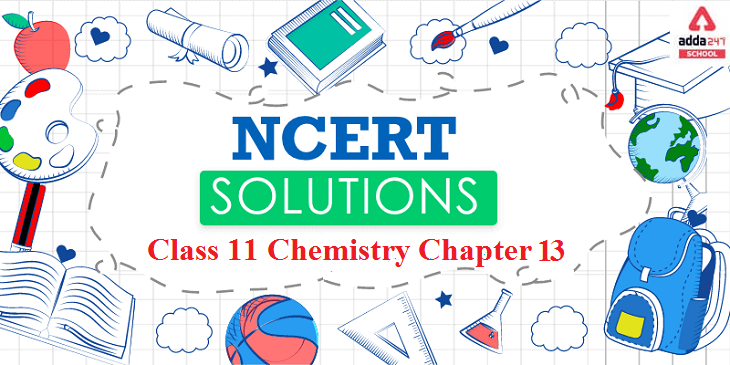Ncert Solutions For Class 11 Chemistry Chapter 13 in English
Adda247 provides NCERT Solutions for class 11 Chemistry. The NCERT Solutions provided here will enhance the concepts of the students, as well as suggest alternative methods to solve particular problems to the teachers.
Chemistry is much more than the language of Science. We aim to aid the students with answering the questions correctly using logical approach and methodology. The NCERT Solutions provide ample material to enable students to form a good base with the fundamentals of the subject.
Students who are looking for Class 11 Chemistry NCERT Solutions can refer to this article. Students will be provided detailed Class 11 Chemistry NCERT Solutions. Students can find here NCERT Solutions of Class 11 Chemistry PDF in Hindi and English medium.
Students of Class 11 must be through with Science NCERT Class 11 Chemistry Solutions in order to secure good marks in the board exams. These solutions will not only help the students to prepare for board exams but also prepare for competitive medical and engineering entrance exams.
Chemistry is an interesting subject but many of your students might find it confusing to understand. It can be a struggle for many of you.
From the NCERT Solutions at Adda247, students will clearly learn about all the chemical reactions which occur in our day to day life. The solutions explain each and every minute concept in a best way possible so that students do not face any problem in the exam. It not only boost their exam preparation but also provides a strong foundation of fundamental concepts which frequently appear in various competitive exams. Using these solutions, students will understand how to approach complex questions that would arise in the exam and answer them with full confidence.
Benefits of Solutions of NCERT class 11 Chemistry:
- NCERT Solutions for Class 11 is helpful to solve questions from other reference books too.
- NCERT Solutions for class 11 Chemistry will assist students to cross check answers and prepare for the exams in a strategic way.
The students can access the solutions anywhere while browsing web easily. The solutions are very precise and accurate.
NCERT Solutions of Chemistry Class 11 Chapter 13: Hydrocarbons
Hydrogen is the most abundant in this universe, and thus any knowledge about this element allows one to explore numerous scientific phenomenon. Keeping this aspect in mind, CBSE has incorporated this topic into their curriculum so that keen students can learn the basic of this element.
Such a topic may seem challenging for students to decipher. In such a synopsis, they can rely on Hydrogen Class 11 Chemistry NCERT Solutions that provide comprehensive guidance on this topic with its eloquent explanation.
[sso_enhancement_lead_form_manual title=”Download Full PDF of Class 11 Chemistry Chapter 13 ” button =”Download Now” pdf =”/jobs/wp-content/uploads/2021/07/13013912/chapter-13-11th-class.pdf”]
Adda247 provides Class 11 Chemistry Chapter 13 NCERT Solutions and easy notes in the PDF form. You can register on the site and get more knowledge about hydrocarbons. NCERT Class 11 Chemistry Chapter 13 available on the main site for free download will allow students to gain more knowledge about the Hydrocarbons and score more in your examinations.
The term hydrocarbon refers to the most basic type of organic molecules. They are comprised of only 2 elements: hydrogen and carbon, hence the name hydrocarbons.
There are many hydrocarbons. They can be classified into two main classes: aliphatic and the aromatic hydrocarbons.
There are four main types of hydrocarbons: Alkanes, Alkenes, Alkynes, and Aromatic hydrocarbons. The simplest hydrocarbons are called alkanes.
Which hydrocarbons are used most in modern life? Hydrocarbons are the principal constituents of petroleum and natural gas. They serve as fuels and lubricants as well as raw materials for the production of plastics, fibres, rubbers, solvents, explosives, and industrial chemicals.
The formula for acyclic saturated hydrocarbons (i.e., alkanes) is CnH2n+2. The most general form of saturated hydrocarbons is CnH2n+2(1-r), where r is the number of rings. Unsaturated hydrocarbons have one or more double or triple bonds between carbon atoms.
Hydrocarbons are organic compounds composed of only carbon and hydrogen. The alkanes are saturated hydrocarbons—that is, hydrocarbons that contain only single bonds. Alkenes contain one or more carbon-carbon double bonds.
The combustion of hydrocarbon fuels releases carbon dioxide (CO2), as well as other greenhouse gases that contribute to atmospheric pollution and climate change. Unlike fossil fuel impurities that result in by-product emissions, CO2 is an unavoidable result of hydrocarbon combustion. Petroleum and coal are the major sources of hydrocarbons.
The longest hydrocarbons have very high boiling points. They leave the column as a hot liquid called bitumen. Shorter hydrocarbon molecules have weaker intermolecular forces and lower boiling points. They are highly volatile and therefore extremely flammable.
Propane is used as a fuel and is used to make chemicals. Can be cheap. Provides energy quickly and is moderately reliable. The amount of carbon dioxide released can be controlled. The amount of other gases released, such as sulphur impurities, can also be reduced by being refined further (although this process would be expensive).
Key features of NCERT Solution for class 12 Chemistry Chapter 5: Surface Chemistry
- The NCERT Solution provide clear and precise answer.
- The columns are used wherever necessary.
- We follow the NCERT guidelines.
- Illustration through diagrams.
- Adequate examples for better explanation
Important questions of NCERT Solutions of Chemistry Class 11 Chapter 13
Question :1 Arrange the following set of compounds in order of their decreasing relative with an electronics, E+
- Chlorobenzene, 2,4-dinitochlorobenzene,p-nitrochlorobenzene
- Toluene, p-H3C-C6H4-NO2, p-O2N-C6H4-No2.
Answer:
Electrophiles are reagents that participate in a reaction by accepting an electron pair in order to bond to nucleophiles.
The higher the electron density on a benzene ring, the more reactive is the compound towards an electrophile, E+ (Electrophilic reaction).
(a) The presence of an electron withdrawing group (i.e., NO2- and Cl-) deactivates the aromatic ring by decreasing the electron density.
Since NO2- group is more electron withdrawing (due to resonance effect) than the Cl- group (due to inductive effect), the decreasing order of reactivity is as follows:
Chlorobenzene > p – nitrochlorobenzene > 2, 4 – dinitrochlorobenzene
(b) While CH3- is an electron donating group, NO2- group is electron withdrawing. Hence, toluene will have the maximum electron density and is most easily attacked by E+.
NO2- is an electron withdrawing group. Hence, when the number of NO2- substituents is greater, the order is as follows:
Toluene > p-CH3-C6H4-NO2, p -O2 N-C6H4-NO2
Question :2 Out of benzene, m-dinitrobenzene and toluene which will undergo nitration most easily and why?
Answer:
The ease of nitration depends on the presence of electron density on the compound to form nitrates. Nitration reactions are examples of electrophilic substitution reactions where an electron-rich species is attacked by a nitronium ion (NO2-).
Now, CH3- group is electron donating and NO2- is electron withdrawing. Therefore, toluene will have the maximum electron density among the three compounds followed by benzene. On the other hand, m-Dinitrobenzene will have the least electron density. Hence, it will undergo nitration with difficulty. Hence, the increasing order of nitration is as follows:
Question :3 Suggest the name of a Lewis acid other than anhydrous aluminium chloride which can be used during ethylation of benzene.
Answer:
The ethylation reaction of benzene involves the addition of an ethyl group on the benzene ring. Such a reaction is called Friedel-Craft alkylation reaction. This reaction takes place in the presence of a Lewis acid.
Any Lewis acid like anhydrous FeCl3, SnCl4, BF3, etc. can be used during the regulation of benzene.
Question :4 Why is Wurtz reaction not preferred for the preparation of alkanes containing odd number of carbon atoms? Illustrate your answer by taking one example.
Answer:
In Wurtz reaction, when preferred for the preparation of alkanes containing odd number of carbon atoms, then it means two different alkyl halides are taken and two different alkyl halides can react in three different ways. Therefore a mixture of alkanes is produced.
That’s why Wurtz reaction doesn’t suitable for the preparation of alkanes containing odd number of carbon atoms.
See the example shown in figure .here two different alkyl halides, CH3I and C2H5I are taken for the preparation of the alkanes . But we observed, alkanes are the mixture of Ethane, propane and butane.
Question :5 Why does benzene undergo electrophilic substitution reactions easily and nucleopihilic substitutions with difficulty?
Answer:
Benzene is a planar molecule having delocalized electrons above and below the plane of ring. Hence, it is electron -rich. As a result, it us highly attractive to electron deficient species example electrophiles.
Therefore, it undergoes electrophilic substitution reactions very easily. Nucleophilic are electron – rich. Hence, benzene undergoes nucleophilic substitutions with difficulty.
Question :6 Arrange benzene, n – hexane and ethyne in decreasing order of acidic behaviour. Also give reason for this behavior.
Answer:
Acidic character of a species is defined on the basis of ease with which it can lose its H-atoms.
The hybridization state of carbon in the given compound is:
As the s-character increases, the electronegativity of carbon increases and the electrons of C-H bond pair lie closer to the carbon atom. As a result, partial positive charge of H- atom increases and H+ ions are set free.
The s-character increases in the order:
sp3 < sp2 < sp
Hence, the decreasing order of acidic behaviour is Ethyne > Benzene > Hexane.
Question :7 What effect does branching of an alkane chain has on its boiling point?
Answer :
Alkanes experience inter – molecular Van see Walls forces. The stronger the force, the greater will be the boiling point of the alkene.
As branching increases the surface area of the molecule decreases which results in a small are if contact. As a result, the Van see Walls force also decreases which can be overcome at a relatively lower temperature. Hence, the boiling point of an alkane chain decreases with an increase in branching.
Question : 8 In the alkane H3-CH2-C(CH3)2-CH2-CH(CH3)2, identify primary, secondary, tertiary carbon atoms and give the numberof H atom bonded to each one of these.
Answer:
Primary carbon atoms are those which are bonded to only one carbon atom or none. I. E., they have only one carbon atom as their neighbour or none in case of methane. The given structure has five primary carbon atom s and fifteen hydrogen atoms attached to it.
Secondary carbon atoms are those which are bonded to two carbon atoms example they have two carbon atoms as their neighbours. The given structure has two secondary carbon atoms and four hydrogen atoms attached to it.
Tertiary carbon atoms are those which are bonded to three carbon atoms example they have three carbon atoms as their neighbours. The given structure has one tertiary carbon atom and only one hydrogen atom is attached to it.
Question :9 What are the necessary conditions for any system to be aromatic?
Answer:
A compound is said to be aromatic if it satisfies the following conditions:
- It should have a planar structure.
- It should be cyclic.
III. The electrons of the compound are completely delocalized in the ring.
- The total number of electrons present in the ring should be equal to (4n + 2) L, where, n = 0,1,2 etc. This is known as Huckel’s rule.
Question :10 Why is benzene extra ordinarily stable though it contains three double bonds?
Answer:
Benzene is a hybrid of resonating structures.
All six carbon atoms in benzene are sp2 hybridized. The two sp2 hybrid orbitals of each carbon atom overlap with the sp2 hybrid orbitals of adjacent carbon atoms to form six sigma bonds in the hexagonal plane. The remaining sp2 hybrid orbital on each carbon atom overlaps with the s-orbital of hydrogen to form six sigma C-H bonds. The remaining unhybridized p-orbital of carbon atoms has the possibility of forming three π bonds by the lateral overlap of . C1 – C2, C3- C4, C5 – C6, or C2 – C3, C4-C5, C6-C1.
The six π’s are delocalized and can move freely about the six carbon nuclei. Even after the presence of three double bonds, these delocalized π-electrons stabilize benzene
Frequently asked questions on NCERT Solutions of Chemistry Class 11 Chapter 13
- What is the significance of Hydrocarbons?
Ans. Hydrocarbons are the major constituents of petroleum and natural gas. They are used as fuels and lubricants as well as raw materials for the production of plastics, fibres, rubbers, solvents,. Explosives, and industrial chemicals.
- What are the topics covered under NCERT Solutions for Class 11 Chemistry Chapter 13?
Ans. NCERTR solutions for Class 11 Chemistry Chapter 13 includes the following topics:
- Classification
- Alkanes
- Nomenclature and Isomerism
- Preparation
- Conformations
- Alkenes
- Structure of Double Bond
- Nomenclature
- Isomerism
- Preparation
- Properties
- Alkynes
- Nomenclature and Isomerism
- Structure of Triple Bond
- Preparation
- Properties
- Aromatic Hydrocarbons
- Nomenclature and isomerism
- Structure of Benzene
- Aromaticity
- Preparation of Benzene
- Properties
- Directive influence of a Functional Group in Monosubstituted Benzene
- Carcinogenicity and Toxicity.
- Why should we follow NCERT Solutions for Class 11 Chemistry Chapter 13?
Ans. NCERT Solutions for Class 11 Chemistry Chapter 13 is the best reference material that offers complete and quality information about different Math concepts. The questions that have been given in the solutions have been solved in an easy-to-remember format, which further helps students to clearly understand and remember the answers. So, it’s clear that NCERT Textbooks for class 11 are essential reference books to score high in examinations. To score good marks, practising these solutions for class 11 Chemistry can help to a great extent.









 ICMAI CMA Foundation Result 2025 Out, Do...
ICMAI CMA Foundation Result 2025 Out, Do...
 NEET UG 2026 Registration: NTA releases ...
NEET UG 2026 Registration: NTA releases ...
 CUET UG 2026 Online Registration Started...
CUET UG 2026 Online Registration Started...














